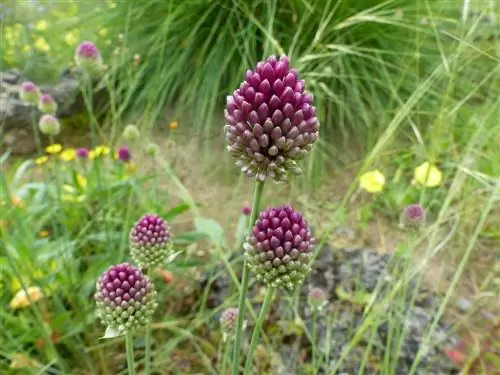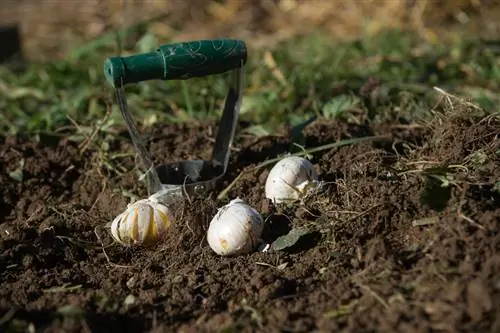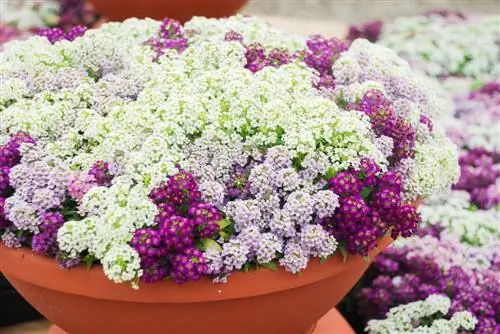- Author admin [email protected].
- Public 2023-12-16 16:46.
- Last modified 2025-06-01 06:02.
Read a commented ball garlic profile here with explanations of growth, flowering, leaves and use. You can find out how to properly plant and care for ornamental onions here.

Which growing conditions does ball garlic prefer?
Sphere garlic (Allium sphaerocephalon) is a hardy ornamental plant with grass-like leaves and purple-red spherical flowers that bloom from June to August. For splendid growth, ball garlic prefers a sunny to shady, warm and wind-protected location with well-drained, moderately dry and calcareous soil.
Profile
- Scientific name: Allium sphaerocephalon
- Genus: Leek (Allium)
- Family: Amaryllis family (Amaryllidaceae)
- Synonyms: ornamental leek, ball-headed leek
- Occurrence: Europe, Canary Islands
- Growth type: perennial, bulb flower
- Growth height: 50 cm to 100 cm
- Leaf: ruler, grass-like
- Flower: spherical umbel
- Fruit: Capsule
- Winter hardiness: hardy
- Use: perennial bed, cottage garden, bee pasture
Growth
Ball garlic is a herbaceous, perennial onion plant from the amaryllis family (Amaryllidaceae). From the Mediterranean to the Caucasus, the perennial prefers to inhabit dry green areas, light bushes, sunny vineyards and open fallow land. The native plant species of the leek genus (Allium) is also aptly called ornamental leek and ball-headed leek. In contrast to chives (Allium schoenoprasum), garlic (Allium sativum), leeks (Allium porrum) and other tasty conspecifics, the focus of ball garlic is on this flower-rich growth:
- Growth habit: clumpy, upright perennial with round-oval inflorescences and grass-like leaves.
- Growth height: 50 cm to 100 cm.
- Growth width: 20 cm to 30 cm.
- Roots: 3.5 cm large bulb as a survival organ.
- Gardenically interesting properties: easy to care for, hardy, edible, bee-friendly, tolerates cutting, long-lasting, high ornamental value.
Bloom
Kugellauch is the lighthouse in the summer sea of flowers. Unmissable flowers with these characteristics are enthroned on sturdy stems:
- Inflorescence: Umbel with numerous individual flowers.
- Flower shape: rounded to ovoid, tapering.
- Flower size: 1 cm to 4 cm in diameter.
- Flower color: purple-red to purple-violet.
- Flowering time: June to August.
- flower ecology: hermaphrodite
With a nectar and pollen value of 4, purple allium is one of the best bee pastures, as the following video proves:
Video: Flowering time on bulbous garlic makes bees' hearts beat faster
Leaf
In the lower area, the tightly upright inflorescence stem is surrounded by these decorative ornamental onion leaves:
- Leaf shape: sessile, narrow-linear to strap-shaped, smooth-edged.
- Leaf color: green to blue-green.
- Special features: hollow inside, edible
Fruit
Pollinated bulb garlic flowers turn into capsule fruits by autumn. The black seeds it contains are light germinators and cool germinators. Ball-headed leeks diligently self-sow to reproduce, which is not always well received by hobby gardeners.
Usage
Ball garlic fits harmoniously into any garden style. The floral versatility is a source of inspiration for creative and natural uses, as the following table shows:
| Garden Style | Ideas, tips, tricks |
|---|---|
| Perennial bed | Globe leek as a leading perennial |
| Natural Garden | Wildflower meadow with bulbous garlic as a bee pasture |
| Cottage Garden | Fence peepers on the picket fence |
| Front yard | Backdrop plant for the sunny flowerbed |
| Flowerbed | Cut flowers for the vase and the dry bouquet |
| Prairie Garden | Splash of color with lighthouse effect in the tall grass prairie |
| Balcony | Container plant with petunias and snake beard as underplanting |
Globe leek is often planted in the herb garden as a decorative culinary herb. All parts of Allium sphaerocephalon are edible and can be used as a herb.
Planting bulb garlic
In late summer you can buy bulb onions cheaply for around 3.90 euros. Price-conscious hobby gardeners prefer planting by propagation. Ornamental allium bulbs are best planted from September to November. Where and how to plant ball garlic correctly, read here:
Propagation
As a mother plant, ball-headed leeks eagerly produce daughter bulbs. These breeding bulbs serve as ideal starting material for easy, vegetative propagation. This is how it works:
- The best time is in autumn.
- Dig up the ball garlic mother plant.
- Place the onion on a firm surface.
- Cut off the onions with a sharp, disinfected knife.
- Spin cuts with rock dust or charcoal ash.
- Replant flower bulbs, water and mulch.
If you don't want to dig up your bulbous leek, wait until you sow it yourself. You can transplant seedlings with several leaves and a height of 10 centimeters or more to a suitable location in autumn. In contrast, generative propagation by sowing is a time-consuming undertaking. Allium sphaerocephalon seeds only germinate after several weeks of cold stimulus. It takes two to three years for a ball garlic seedling to bloom.
Location
For magnificent growth and a long flowering period, ball leeks are planted at this location:
- Sunny to sunny location.
- Warm and protected from the wind.
- Normal garden soil, preferably sandy and permeable, moderately dry and calcareous.
Planting Tips
Important criteria for the competent planting of flower bulbs are good soil preparation, the correct orientation of the bulb and a well-measured planting distance. You can read useful details in these planting tips:
- To prepare, dig the soil to the depth of a spade, pull weeds, improve loamy soil with sand.
- The planting pit corresponds to twice to three times the volume of a bulb onion.
- A thin layer of sand or lava granules on the bottom of the pit prevents waterlogging.
- The bulb is planted with the pointed tip upwards.
- In group planting, the planting distance is 15 cm to 20 cm.
A mulch layer of compost provides valuable nutrients for the first flowering period. Marking the planting site with a wooden stick serves as a practical guide.
Excursus
Combine ball garlic imaginatively - tips
Perennials with purple, pink, orange-red and white flowers primarily harmonize with purple bulb garlic as the leading perennial. Magnificent planting partners are lavender (Lavandula angustifolia), steppe sage (Salvia nemorosa), yarrow 'Belle Epoque' (Achillea millefolium), meadow sage (Salvia pratensis) and speedwell (Veronica spicata). Delicate lightness comes into play with ornamental grasses such as pearl grass (Melica), feather grass (Stipa tenuissima) and delicate Japanese sedge (Carex morrowii var. temnolepis).
Care for bulb garlic
Ball garlic is very easy to care for. The mainstays of the simple care program are watering, fertilizing and cutting. The best care tips for ornamental garlic to read:
Pouring
- Water ball garlic sparingly with normal tap water.
- Water thoroughly once a week during summer droughts.
Fertilize
- Fertilize Allium sphaerocephalon in March and June with compost and horn shavings.
- Alternatively, use a complete organic fertilizer with a high phosphate and low nitrogen content.
- Extra tip: A portion of compost after the autumn pruning will reward ball garlic with particularly beautiful flowers in spring.
Cutting
- Remove wilted flowers promptly to prevent seed-rich fruits from forming.
- Cut off stems and leaves at ground level at the earliest when the plant parts are completely brown and dead.
Wintering
- Ball garlic flower bulbs are hardy and can remain in the ground.
- To protect against rot caused by winter moisture, the root disk is covered with leaves and brushwood.
Diseases and pests
Robust ball leeks rarely cause complaints about diseases and pests. Aphids that occasionally appear are simply showered off. You can collect voracious snails early in the morning. A traveling barrier made of grit or wood chips keeps the pests at a distance.
Popular varieties
Apart from the original Allium sphaerocephalon, no other ball garlic varieties are commercially available. Nevertheless, there are alternative leek species and varieties with spherical flower heads to discover in tree nurseries and garden centers:
- Ball leek 'Purple Sensation': Allium aflatunense with purple-violet ball flowers, flowering time in May, height 30 cm to 80 cm.
- Giant Leek: Allium giganteum boasts purple-red flower balls that rise on stems up to 180 cm high in July.
- Blue tongue bulb onion: delicate Allium karataviense blooms from April to May with pink-white flower balls, height 10 cm to 25 cm.
- Ornamental onion 'Cliffs of Dover': Allium tuberosum delights with white, hemispherical flowers and edible leaves with a spicy garlic flavor, growth height 20 cm to 70 cm.
FAQ
What is the name of the flower with purple ball flowers?
The answer may surprise you, because it is a close relative of chives (Allium schoenoprasum), onions (Allium cepa) and other tasty allium plants. Ball-headed leek (Allium sphaerocephalon), also known as ball-headed leek, blooms in summer with purple flower balls on stems up to 100 cm high. One floor higher, a man-sized giant leek (Allium giganteum) bears its purple flower balls.
Ornamental onion leaves turn yellow before flowering. Cut it or leave it?
It is no cause for concern if allium leaves turn yellow before flowering. Ball garlic (Allium sphaerocephalon), giant leek (Allium giganteum) and other leek species pull in their leaves before the first flowers develop. Under no circumstances should you cut off yellow ornamental garlic leaves too quickly. The nutrients it contains are transferred to the onion and make an important contribution to energy reserves for the next year.
Which perennials can you plant ball leeks with?
Global allium likes to surround itself with half-height ornamental grasses that caress its flower balls and hide the yellowing foliage. Recommended planting partners are: prairie drop grass (Sporobolus), Mexican egret grass (Stipa tenuissima) and pearl grass (Melica). The purple-violet flower balls float decoratively above low perennials such as lavender (Lavendula), gypsophila (Gypsophila), cranesbill (Geranium) and floribunda roses (Rosa).
Can you grow bulbous garlic from seeds?
It is possible to propagate ball garlic by sowing. However, growing from seeds is a delicate and time-consuming undertaking. Allium sphaerocephalon seeds are equipped with germination inhibition. In order to overcome this inhibition threshold, the seeds must complete a cold phase lasting several weeks after an initial warm period. This works best in the vegetable compartment of the refrigerator or on the winter balcony.
Do you have to dig up the garlic bulbs before winter, like dahlia tubers?
Ball garlic (Allium sphaerocephalon) is a native perennial and hardy down to -35° Celsius. For this reason you can leave the flower bulbs in the ground all year round. The winter cold stimulus activates the bud formation for the next flowering period. In contrast, frost-sensitive dahlia tubers are dug up for frost-free wintering indoors.






